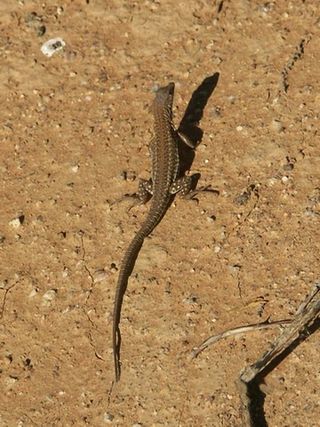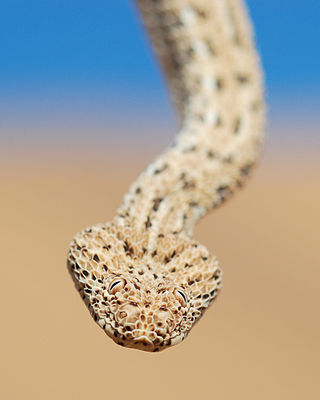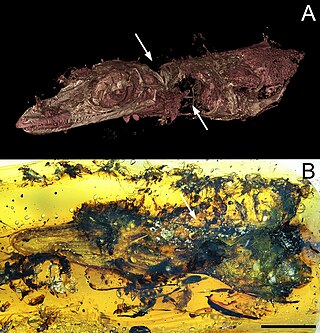
Lizard is the common name used for all squamate reptiles other than snakes, encompassing over 7,000 species, ranging across all continents except Antarctica, as well as most oceanic island chains. The grouping is paraphyletic as some lizards are more closely related to snakes than they are to other lizards. Lizards range in size from chameleons and geckos a few centimeters long to the 3-meter-long Komodo dragon.

The Lacertidae are the family of the wall lizards, true lizards, or sometimes simply lacertas, which are native to Afro-Eurasia. It is a diverse family with at about 360 species in 39 genera. They represent the dominant group of reptiles found in Europe.

The Lizard is a character appearing in American comic books published by Marvel Comics. Created by Stan Lee and Steve Ditko, he first appeared in The Amazing Spider-Man #6 as an enemy of the superhero Spider-Man. While the character has retained this role throughout most of his subsequent appearances, he has also been portrayed as a tragic antihero and occasional ally of Spider-Man. Connors is sometimes an ally of Spider-Man just as himself, and not necessarily as his alter ego.

Fringe-toed lizards are lizards of the genus Uma in the family Phrynosomatidae, native to deserts of North America. They are adapted for life in sandy deserts with fringe-like scales on their hind toes hence their common name.

Monitor lizards are lizards in the genus Varanus, the only extant genus in the family Varanidae. They are native to Africa, Asia, and Oceania, and one species is also found in the Americas as an invasive species. About 80 species are recognized.

Meroles is a genus of lizards, commonly known as desert lizards, in the family Lacertidae. The genus contains eight species, inhabiting southwestern Africa, especially the Namib Desert.

Nucras is a genus of African lacertid lizards, commonly called sandveld lizards.
José Alberto de Oliveira Anchieta was a 19th-century Portuguese explorer and naturalist who, between 1866 and 1897, travelled extensively in Portuguese Angola, Africa, collecting animals and plants. His specimens from Angola and Mozambique were sent out to Portugal, where they were later examined by several zoologists and botanists, chiefly among them J.V. Barboza du Bocage.

Bitis peringueyi, also known as the Peringuey's adder, Peringuey's desert adder or desert sidewinding adder, is a viper species found in Namibia and southern Angola. No subspecies are currently recognized.

Femoral pores are a part of a holocrine secretory gland found on the inside of the thighs of certain lizards and amphisbaenians which releases pheromones to attract mates or mark territory. In certain species only the male has these pores and in other species, both sexes have them, with the male's being larger. Femoral pores appear as a series of pits or holes within a row of scales on the ventral portion of the animal's thigh.
Meroles ctenodactylus, also known as the giant desert lizard, Smith's sand lizard or Smith's desert lizard, is a species of sand-dwelling lizard in the family Lacertidae. It occurs in westernmost South Africa and western Namibia.

Meroles squamulosa is a species of African lizard originally placed in the genus Ichnotropis, however phylogenetic evidence moves this species to the genus Meroles. The species is commonly called the common rough-scaled lizard or savanna lizard. It is largely found in southern Africa. These lizards are terrestrial and found in the range of mesic savannah. The common rough-scaled lizard is medium in size and well distributed in parts of Namibia, Botswana, Zimbabwe, Angola, Tanzania, and Zambia.

Meroles cuneirostris, the wedge-snouted sand lizard or wedge-snouted desert lizard, is a species of sand-dwelling lizard in the family Lacertidae. It occurs in the Namib Desert of Namibia and South Africa.

Meroles knoxii, also known commonly as Knox's desert lizard and Knox's ocellated sand lizard, is a species of sand-dwelling lizard in the family Lacertidae. The species is native to southern Africa.
There are two species of lizard named small-scaled desert lizard:
Meroles reticulatus, the reticulate sand lizard, is a species of sand-dwelling lizard in the family Lacertidae. It occurs in Namibia and Angola.
Pedioplanis rubens, called commonly the Waterberg sand lizard, reddish sand lizard, and (misleadingly) Ruben's sand lizard, is a species of lizard in the family Lacertidae. The species is endemic to Namibia.
Pseuderemias savagei is a species of lizard in the family Lacertidae. The species is endemic to Somalia.

Oculudentavis is an extinct genus of lizard of uncertain taxonomic placement, originally identified as an avialan dinosaur. It contains two known species, O. khaungraae and O. naga. Each species is known from one partial fossil specimen in Burmese amber, which differ in several proportions. Their skulls measure 1.4–1.7 centimetres (0.55–0.67 in) in length, indicating that Oculudentavis would have been comparable in size with the modern bee hummingbird if it were an avialan. Both specimens were retrieved from 99-million-year-old deposits of the Hukawng Basin in Kachin State, northern Myanmar. The type specimen of O. khaungraae is embroiled in controversy regarding its identity and the ethical issues surrounding the acquisition and study of Burmese amber. The original description advocating for an avialan identity was published in Nature, but has since then been retracted from the journal.










